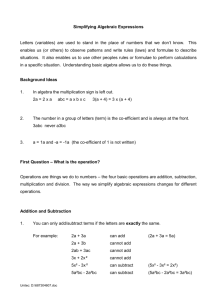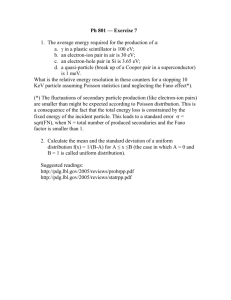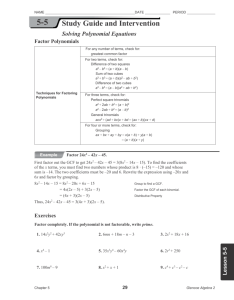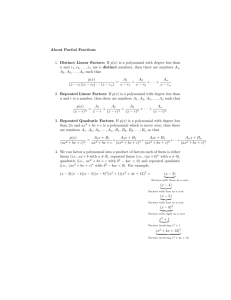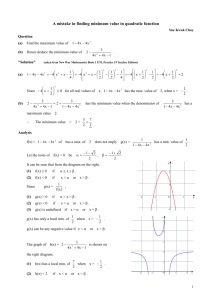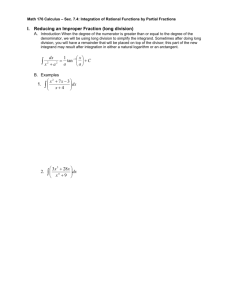Some algebra drill problems
advertisement
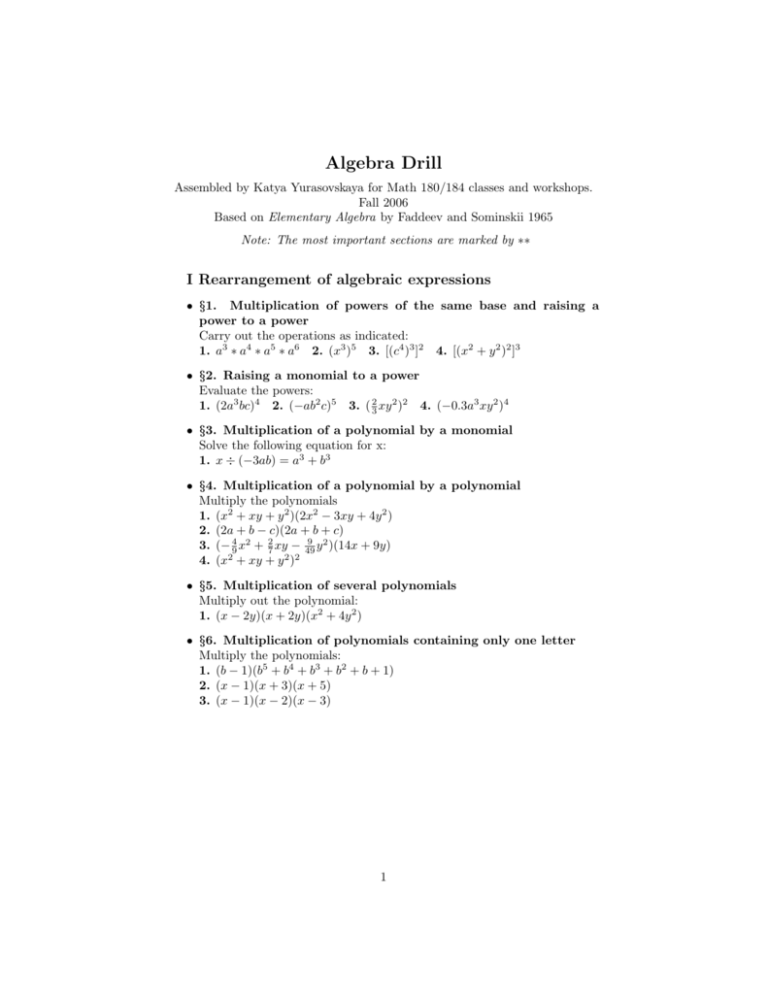
Algebra Drill Assembled by Katya Yurasovskaya for Math 180/184 classes and workshops. Fall 2006 Based on Elementary Algebra by Faddeev and Sominskii 1965 Note: The most important sections are marked by ∗∗ I Rearrangement of algebraic expressions • §1. Multiplication of powers of the same base and raising a power to a power Carry out the operations as indicated: 1. a3 ∗ a4 ∗ a5 ∗ a6 2. (x3 )5 3. [(c4 )3 ]2 4. [(x2 + y 2 )2 ]3 • §2. Raising a monomial to a power Evaluate the powers: 1. (2a3 bc)4 2. (−ab2 c)5 3. ( 32 xy 2 )2 4. (−0.3a3 xy 2 )4 • §3. Multiplication of a polynomial by a monomial Solve the following equation for x: 1. x ÷ (−3ab) = a3 + b3 • §4. Multiplication of a polynomial by a polynomial Multiply the polynomials 1. (x2 + xy + y 2 )(2x2 − 3xy + 4y 2 ) 2. (2a + b − c)(2a + b + c) 9 2 y )(14x + 9y) 3. (− 94 x2 + 27 xy − 49 2 2 2 4. (x + xy + y ) • §5. Multiplication of several polynomials Multiply out the polynomial: 1. (x − 2y)(x + 2y)(x2 + 4y 2 ) • §6. Multiplication of polynomials containing only one letter Multiply the polynomials: 1. (b − 1)(b5 + b4 + b3 + b2 + b + 1) 2. (x − 1)(x + 3)(x + 5) 3. (x − 1)(x − 2)(x − 3) 1 • * * §7. Rapid multiplication by formulae (A + B)2 = A2 + 2AB + B 2 (A − B)2 = A2 − 2AB + B 2 ) (A + B)(A − B) = A2 − B 2 (A + B)3 = a3 + 3A2 B + 3AB 2 + B 3 (A − B)3 = A3 − 3A2 B + 3AB 2 − B 3 (A + B)(A2 − AB + B 2 ) = A3 + B 3 (A − B)(A2 + AB + B 2 ) = A3 − B 3 Use formulaes to do the following multiplications: 1. (3ab − x2 )(3ab + x2 ) 2. (x − 1)(x + 1)(x2 + 1) 3. (a + b)2 (a − b)2 (Solve by two methods) 4. (a2 + 3ab + b2 )(a2 − 3ab + b2 ) 5. (3x − 2y)(9x2 + 6xy + 4y 2 ) 6. (2x + 1)3 7. (−a − b)2 Solve the following equations for x: 9. (a + b)x = a2 − b2 10. (3a2 − 2b)x = 9a2 − 4b2 11. (2p + 3q)x = 4p2 + 12pq + 9q 2 12. (a3 − 8b3 ) ÷ x = a − 2b 13. x ÷ (3p + q) = 9p2 − 3pq + q 2 II Factorization of Polynomials • §1. The method of grouping Factorize: 1. a3 + a − 2ab + 3 + 3a2 − 6b 2. a3 + a + 3a2 + a • §2. Splitting individual terms of a polynomial into similar terms EXAMPLE: Factorize a2 + 3ab + 2b2 Solution: a2 + 3ab + 2b2 = a2 + ab + 2ab + 2b2 = a(a + b) + 2b(a + b) = (a + 2b)(a + b) Factorize: 1. x2 + ax − 2a2 2. (x3 + 3bx − 4b2 x 3. x4 + 5x2 y 2 + 6y 4 2 • * *§3. The use of multiplication formulae Factorize: 1. x4 − 16y 4 2. 4xy 3 − 4x3 y 3. a2 + 6ab + 9b2 − 4c2 4. 8x4 − 27a3 x 5. 4xy − xyz 2 6. x2 + 2x − y 2 − 2y • * * * §4. More complicated examples Factorize: 1. x5 + x3 − x2 − 1 2. a4 − 2a3 b − 8a2 b2 − 6ab3 − b4 3. x2 y + xy 2 + x2 z + xz 2 + y 2 z + yz 2 + 3xyz 4. x4 + 2x3 + 3x2 + 2x + 1 5. x5 − 1 III The rearrangement of fractional algebraic expressions • §1. No ”division by zero” ! For what values of the symbols are the following algebraic expressions meaningful? 1 1. x−9 x2 − 64 2. x−8 1 1 3. + x y 4. 1 x 1 x + − 1 y 1 y • §2. Division by powers of the same base Divide: 1. a7 by a3 2. c2 by c5 3. b11 by b11 Find x in: 4. x ÷ a2 = a5 5. a3 ÷ x = a7 6. x ∗ a2 = a4 • §3. Division of monomials Do the following divisions: 3 ∗ 2a3 bpq 1. 0.1a2 bc ÷ (−0.01ab) 2. 2 ∗ 4ab 3. 7ab2 c ÷ (5a3 b3 c3 ) • * *§4. Division of polynomial by a monomial Examples and ideas: a b c d a+b+c+d = + + + m m m m m 2. abcd + 2abc + 2abd + 2acd + 2bcd 1. 2abc 2abd 2abd 2bcd + + + ) abcd abcd abcd abcd 2 2 2 2 = abcd(1 + + + + ) d c b a = abcd(1 + 3 Carry out the divisions: 1. (3x3 y − 0.1xy 2 + 7.3x2 y) ÷ (−0.1xy) 2. (x2 yz + xy 2 z + xyz 2 ) ÷ (xyz) a3 b + a2 b2 − 3ab3 3. 2ab xy + xz + yz dividing term by term. 4. Rearrange xyz 2 2 5. In the polynomial x y z − xy 2 z 2 + x2 y 2 z 2 takex2 y 2 z 2 outside brackets. • * *§5. The application of multiplication formulae to the division of a polynomial by a polynomial Perform the following divisions: x4 − 16y 2 x3 + 3x2 y + 3xy 2 + y 3 1. 2 2. x + 4y 2 x+y x4 + 6x2 + 9 (a + b)2 − (c + d)2 4. 3. a+b−c−d x2 + 3 Solve for x: 5. x(a + 2b) = a2 − 4b2 6. (a − 3b)x = a2 − 6ab + 9b2 7. (a − b − c)x = a2 − 2ab + b2 − c2 • Find some problems on long division in any algebra book and do 3-4... • §6. Simplification of algebraic fraction Simplify the fractions: x2 + 5x + 6 (x + y2)2 − (2x + y)2 1. 2. x2 − 9 (x + 3y)2 − (3x + y)2 • §7. Addition and subtraction of algebraic fractions Note: review finding common denominators Add the fractions: 1 2x 3x 1. − − x+2 x x−2 2 1 (x + 1)2 2. 1 − + 2 − x x x2 • §8. Multiplication of fractions Multiply the fractions: a+b a4 − b4 1 1 1 1. 2 ∗ 2. (1 + )(1 + )(1 + ) 2 a +b 2ab x x+1 x+2 4 • * *§9. Simplification of fractions in which the numerator and denominator are algebraic sums of fractions Two useful examples: 1. Simplify the expression: 1 1 a + b 1 1 a + b Solution: 1 1 a + b 1 1 = a + b b+a ab b−a ab = b+a ab b+a × = ab b−a b−a 2. Previous example done differently: 1 1 ab( a1 + 1b ) b+a a + b 1 = 1 = b−a 1 1 + − ) ab( a b a b 3. Simplify the expression: 1 1 − x+1 2 + x−1 x+ x x2 −1 Solution: Multiplying the numerator and denominator by x2 − 1 we get 2(x2 − 1) + (x + 1) − (x − 1) 2x2 − 2 + x + 1 − x + 1 2x2 = = = x(x2 − 1) + x x3 − x + x x3 2 x Simplify the fractions: 1 1 1 1 x(x+1) + (x+1)(x+2) x+1 + x−1 2. 1. 1 1 x+2 6x x−1 − x+1 x+2 − x IV Powers and Roots • §1. Properties of powers with integral indices an ∗ am = an+m (am )n = amn (ab)n = an ∗ bn , (abc)n = an bn cn etc an a ( )n = n b b 5 Simplify the expressions: a2 3 b2 ) ∗ ( )4 2. (am−n )m+n for m > n 3. a ∗ (a2 )2 ∗ (a3 )3 b a 4 Calculate (−2)6 and (−3)5 1. ( • §2. The root to any power of a number Note: The positive √ value of an even root is called its arithmetical value. The notation n a for even p n and a > 0 always means the arithmetical value of the root. Thus (−3)2 = 3 (and not −3). Evaluate: p p √ √ √ 1. 4 + 3 27 2. 3 27 + (−2)6 3. (a − 2)2 • §3. Extracting the root of products, fractions and powers √ √ ( n a)n = a, in particular ( a)2 = a) √ n √ n a ∗ b ∗ ... ∗ k = √ n a∗ an = a √ n b ∗ ... ∗ √ n k, for a, b, ...k > 0 √ n a a = √ for a, b > 0 n b b √ √ nk n a= ak for a > 0 r n Rearrange: q √ √ 1. 2 × 3 3 × 5 16 √ √ 2× 33 √ 3. √ 3× 32 √ 3 16 2. √ 8 • §4. Raising a root to a power and extracting the root of a root ( q √ n n a)k = ak q k √ n a= √ nk a p√ √ √ Rearrange: 1. ( 2)4 2. ( 3 5)2 3. 25 6 • §5. Removing a rational factor from under the root sign. Putting a rational factor under the root sign If a and b are√positive numbers then √ n n a b = an b r n √ n b b = n a a Put all factors under the root rsign: q √ a − b a+b 1. 2 3 2. 3 3 13 3. a+b a−b • * *§6 Rationalizing a denominator A fractional expression containing radicals in the denominator can be converted into a fractional expression without radicals in the denominator. This process is called rationalizing the denominator. 1. The denominator is a radical, i.e. the fraction is of the form A √ n b In this case a factor must be chosen which, when multiplied by the base, gives a perfect√nth power √ 5 532 532 5√ 3 √ Example: √ = √ = √ = 2 3 3 3 3 2 4 4 2 8 2. Expression is of form c c √ or √ a+ b a− b √ √ Then multiply numerator and denominator by a − b or a + b respectively. Then we get: √ a c(a − b) c(a − sqrtb) √ = √ √ = a2 − b2 a+ b (a + b)(a − b) 3. The denominator is sum or difference of two square roots, i.e. the fraction is of form c c √ or √ √ √ a+ b a− b Use same method as in the previous case. Rationalize the √ denominators √ √ of: a 2+ 3 2−1 √ 1. √ 2. 3. √ 5 6 2+1 a3 7 a3 − x3 √ 4. √ a− x V Quadratic equations and equations reducing to quadratics • §1. The reduced quadratic equation Reduced quadratic equation x2 + px + q = 0 1. ( 12 p)2 − q < 0 Equation has no solution 2. ( 12 p)2 − q = 0 Equation has only one solution, x = − 12 p 3. ( 12 p)2 − q > 0 Equation has two solutions: r p p x = − ± ( )2 − q 2 2 or equivalently p −p ± p2 − 4q x= 2 Solve: 1. x3 − x − 96 = (x − 1)(x − 2)(x − 3) 2. (x + 1)2 = 2x2 − 7 • * * * §2. The general quadratic equation General quadratic equation: ax+ bx + c = 0 To find roots use quadratic formula √ −b ± b2 − 4ac x= 2a Solve: 1. 5x2 + 3x − 1 = 0 2. (a + b)x2 + (4a − 2b) + b − 5a = 0 3. (x + 1)(x + 2)(x + 3) = x3 + 52 • §3. Factorizing a quadratic trinomial 1. Given reduced quadratic trinomial x2 + px + q with real roots x1 , x2 , the factorized form is x2 + px + q = (x − x1 )(x − x2 ) 2. Given a quadratic trinomial ax2 + bx + c with real roots x1 , x2 , the factorized form is ax2 + bx + c = a(x − x1 )(x − x2 ) Factorize: 1. 3x2 − 10x + 3 2. x2 + 2x − 5 8 Answers Section I §1 1 1 2 2 • 1. a 8 2. x 5 3. c 4 4. (x + y 2 )6 §2 1 4 4 • 1. 16a 2b c 5 1 5 2. −a b 0c 3. 4 2 2 9x y 4. 0.0081a1 2x4 y 8 §3 4 4 • 1. x = −3a b − 3ab §4 4 3 2 2 3 • 1. 2x − x y + 3x y + xy + 4y 4 2. 4a2 + 4ab + b2 − c2 81 3 4. x4 + 2x3 y + 3x2 y 2 + 2xy 3 + y 4 3. − 56 9 x − 49 §5 • 1. x4 − 16y 4 §6 6 3 2 • 1. b − 1 2. x + 7x + 7x − 15 3. x3 − 6x2 + 11x − 6 §7 • 1. 9a2 b2 − x4 2. x4 − 1 3. a4 − 2a2 b2 + b4 4. a4 − 7a2 b2 + b4 5. 27x3 −8y 3 6. 8x3 +12x2 +6x+1 7. a2 +2ab+b2 8. x4 +4x3 +2x2 −4x+1 9. x = a − b 10. x = 3a2 + 2b 11. x = 2p + 3q 12. x = a2 + 2ab + 4b2 13. x = 27p3 + q 3 9 Section II §1 2 • 1. (a + 3)(a + 1 − 2b) 2. (a + 3)(a2 + 1) §2 • 1. (x + 2a)(x − a) 2. x(x + 4b)(x − b) 3. (x2 + 2y 2 )(x2 + 3y 2 §3 2 2 • 1. (x + 2y)(x − 2y)(x + 4y ) 2. 4xy(y + x)(y − x) 3. (a + 3b + 2c)(a + 3b − 2c) 4. x(2x − 3a)(4x2 + 6ax + 9a2 ) 5. xy(2 + z)(2 − z) 6. (x − y)(x + y + 2) Section III §1 • 1. x 6= 9 2. x 6= 8 3. x 6= 0 and y 6= 0 4. x 6= 0 and y 6= 0 and x 6= y §2 • 1. a4 2. 1 c3 3. 1 4. x = a7 5. x = 1 a4 6. x = a2 §3 • 1. −10ac 2. 4 2 3 a pq 3. 7 5a2 bc2 §4 • 1. −30x2 + y − 73x 2. x + y + z 3. 4. x1 + y1 + z1 5. x2 y 2 z 2 ( z1 − x1 + y1 ) a2 +ab−3b2 2 §5 2 2 2 2 • 1. x − 4y 2. x + 2xy + y 3. a + b + c + d 4. x2 + 3 5. x = a − 2b 6. x = a − 3b 7. x = a − b + c §6 • 1. x+2 x−3 • 1. x3 −11x2 +4 x(x2 −4) • 1. (a+b)2 (a−b) 2ab 2. 3 8 §7 2. − x4 §8 2. 2x(x2 +x+1) x+1 §9 • 1. x 2. 2 5x2 −4x−4 10 Section IV §1 2 5 • 1. a b m2 −n2 1 3. a 4 4. x6 + 4x5 − 2x4 − 20x3 − 7x2 + 24x + 16 2. a §2 • 1. 5 2. 11 3. a − 2 for a ≥ 2; 2 − a for a < 2 §3 • 1. √ 30 q 29 × 34 2. • 1. 4 2. √ 3 25 3. 1 2 6 √ 3. q 6 2 3 §4 5 §5 • 1. • 1. √ 12 2. √ 5 a2 2. √ 3 9 3. q √ √ 2 3+3 2 6 a−b a+b §6 √ √ √ 3. 3 − 2 2 4. (a2 + ax + x2 )( a + x) Section V §1 • 1. −3, 5 2. −2, 4 §2 • 1. √ −3± 29 10 2. 1, • 1. 3(x − 3)(x − 1 3) b−5a a+b 3. 2, − 23 6 §3 √ √ 2. (x + 1 − 6)(x + 1 + 6) 11


